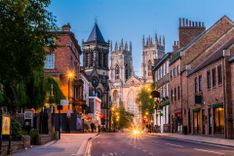18. West Runton Mammoth
Dramatically poised on a high bluff, visiting Cromer resort should be on your list of things to do on Norfolk’s coast. Cromer has a lovely sandy beach, but it can get crowded. If you’re seeking a little more solitude, you may prefer the Runtons, just to the west of Cromer, before you reach Sheringham.
First up along the main coastal road, the A149, is East Runton, where narrow Beach Road cuts an unpromising route through a herd of static caravans before reaching a wide and sandy beach. In neighbouring West Runton, Water Lane serves a similar function. Forking off the A149 bound for another slab of sandy beach, but it’s a rather more pleasant route. There’s a smashing campsite here, too.
19. Great Yarmouth Hippodrome Circus
Great Yarmouth’s seafront stretches for about a mile north to south along Marine Parade and is a fairly predictable mix of B&Bs, amusement arcades and cheap restaurants, anchored by the Britannia Pier to the north and the Wellington Pier to the south.
Britain’s only surviving purpose-built circus building, the Hippodrome sits behind the seafront arcades, more than a century of spectacular summer shows behind it and still going strong. Owned for the past four decades by former pop musician and local boy Peter Jay, it hosts a variety of events, including the Great Yarmouth Summer Spectacular, whose high-class performers are worth coming to see even if you don’t like circuses.
The interior too is a gem, and there’s a small museum stocked with old props, posters and technical equipment that you can visit after attending any event.


























